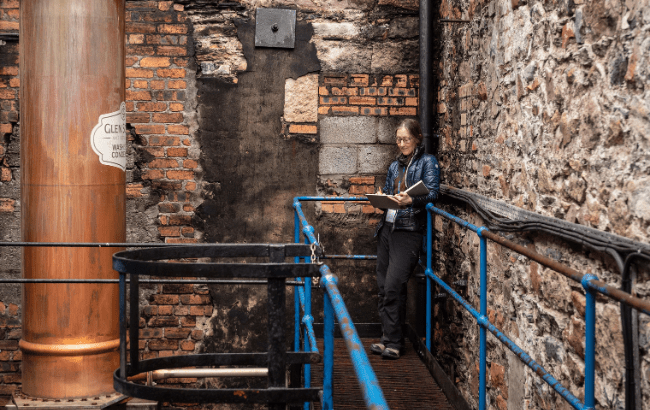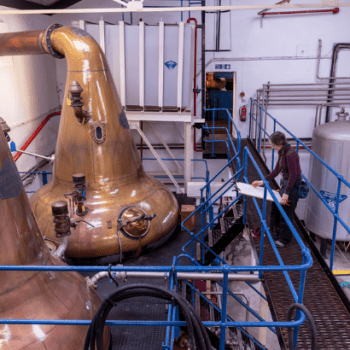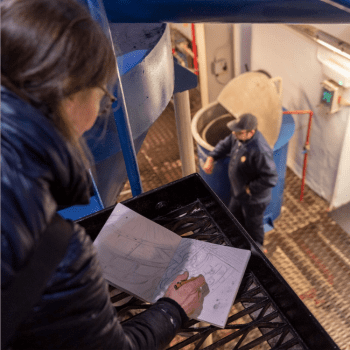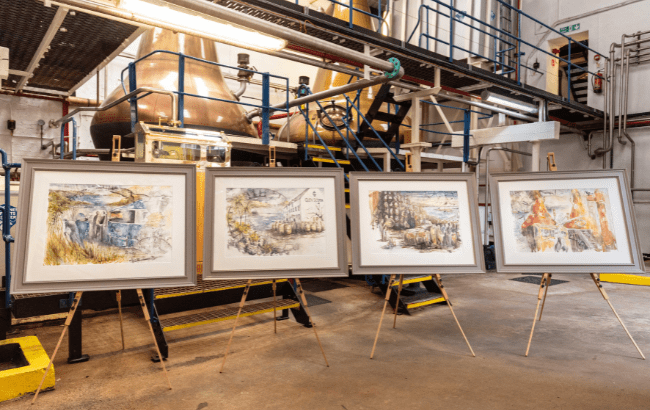SB meets… Glen Scotia’s artist in residence
By Georgie CollinsWhile many say whisky making is an art-form, some producers are adding a new artistic dimension to their distilleries. We spoke to Alice Angus, Glen Scotia’s artist in residence, about her unique role, and how she uses the site’s surroundings as inspiration for her work.

What does it mean to be an artist in residence?
As an artist in residence you are usually working in a specific place and often in partnership with a business, community, organisation, or public body. You do research and make artworks in relation to that context.
You are entering into something that might be unknown to you, responding to the environment and people you meet there. I think many organisations value the new perspectives that artists bring, and the impact of the artist’s presence can be as important than the physical objects that they might make.
What does your role at Glen Scotia entail?
Every project is unique and my role at Glen Scotia was to immerse myself in the life of the distillery itself, the processes, the craft of the people working there, and its setting in Campbeltown.
On a residency like this, I’m aware that I’m going into somebody’s community and workplace, so part of my role is being open about what I’m doing, letting people see me working, trying not to intrude, and getting to know people. The distillery staff at Glen Scotia, and historian and writer Angus Martin, were so generous from the very beginning, and that really set the tone for the whole experience. I was made very welcome and I’m grateful to everyone for that.

How do you prefer to work?
Drawing was central to the residency at Glen Scotia. Drawing is a powerful way of understanding what a place is about because staying in a place drawing for several hours enables you to see rhythms of life: community, wildlife, industry and infrastructures. When I’m drawing, people stop to talk to me and their stories and experiences influence where I go and what I do next. I also do historical research and bring aspects of that together with my observational studies and the conversations I have had with people.
I stayed in the distillery drawing for many hours, often waiting for the right moment. I drew the workings, sounds and smells, talked to the team, and marvelled at the combination of ingredients, chemistry, engineering, people, craft and knowledge that is involved in whisky production. I also observed the atmosphere: the changes in sounds, temperature, humidity, light, vibrations, and smells that I would have missed on a shorter visit. I spent a lot of time drawing in the town and on the harbour and bay as winter changed into spring.
I often work on paper using pencil, watercolour and ink, found materials, homemade tools and brushes.
What is the process behind creating your pieces?
My technique involves patience, time and experimentation. I paint and draw from life, spending a long time observing surroundings through sight, sound, smell and touch and talking to people I meet as I work. I also make more more abstract sketches of the sounds, smell and tastes. I visited Campbeltown about five times for 7-10 days each time and drew from life in the distillery and around Campbeltown and Kintyre. I often visited and drew the places or things things people told me about.
Drawing is many things; a fast process to capture fleeting moments, a slow process that reveals things over time and an abstract way to explore atmosphere. The long and sometimes slow process of drawing was central to the residency and it enabled everything I learned and experienced in Glen Scotia.
How does Glen Scotia’s whisky and distillery influence your work? How has it inspired you?

I was very fortunate that Iain McAlister introduced me to poet, author and historian Angus Martin, whose writing, conversations and walks have inspired much of my work. I’ve been inspired by listening to the people who work in the distillery, by the ingredients, skills, engineering and care that goes into making whisky, and all the rhythms of time across hours, days, years and decades involved in its creation.
When you stay for a long time drawing you see the hands-on process; the people making the whisky pay attention to everything that’s going on around them (the sounds, smells, vibrations, readings) and bring it all together at just the right time. Their attention to detail was inspiring, and in a small way reflected in the attention to detail I put in some of my drawings. People are at the heart of the distillery.
The first impression on entering the still house is of copper, brass, heat, and smells of spirit and yeast. I drew the stills often, returning in order to start seeing, hearing and smelling everything else that’s beyond the obvious. It’s like when you first taste whisky; it might start off fiery and you have to let it warm up, maybe have a splash of water and maybe sit with it for a while before all the other layers of flavours and the subtleties come through.
I spent some bitterly cold winter days drawing in the dark, still, warehouses, noticing the aromas change throughout the hours, as air moved around maturing casks. Spending a long time drawing the casks let me see how each one is different, handmade, telling the story of the generations of people that have looked after them as the spirit matures.
When not in the distillery I was out in Campbeltown or up at Crosshill Loch (the source of water for Campbeltown whisky), or along the coast, in all weathers as the tide came and went and wildlife passed by. Campbeltown has a unique gulf stream climate, visitors are surprised to find huge palm trees and lush plants growing, next to hardy gorse, wild birds like eiders and turnstones on the water and ravens kronking overhead.

How is your art utilised at the distillery?
Four large paintings were commissioned by Glen Scotia (pictured above) and I created an associated series of work for an exhibition in which I brought together many of the different impressions and stories about engineering, water, barley, time, dedication, people and what is important and unique to the making of whisky at Glen Scotia. This was first shown at the Campbeltown Malts Festival 2022. I am currently making a second series inspired by both the people and the atmosphere of heat and steam in the distillery alongside a new set of works about the sensory experiences of taste, smell and sound.
Glen Scotia plan to auction the paintings for charity and they will appear on the boxes and bottles of ‘Spirit Safe’ a limited edition of 120 bottles of Glen Scotia 30-year-old.
For more information on Angus’ work at Glen Scotia, visit www.glenscotia.com/pages/alice-angus-scottish-artist
In January, Glen Scotia debuted a 21-year-old whisky.
Related news
World Spirits Report 2025: World whisky
